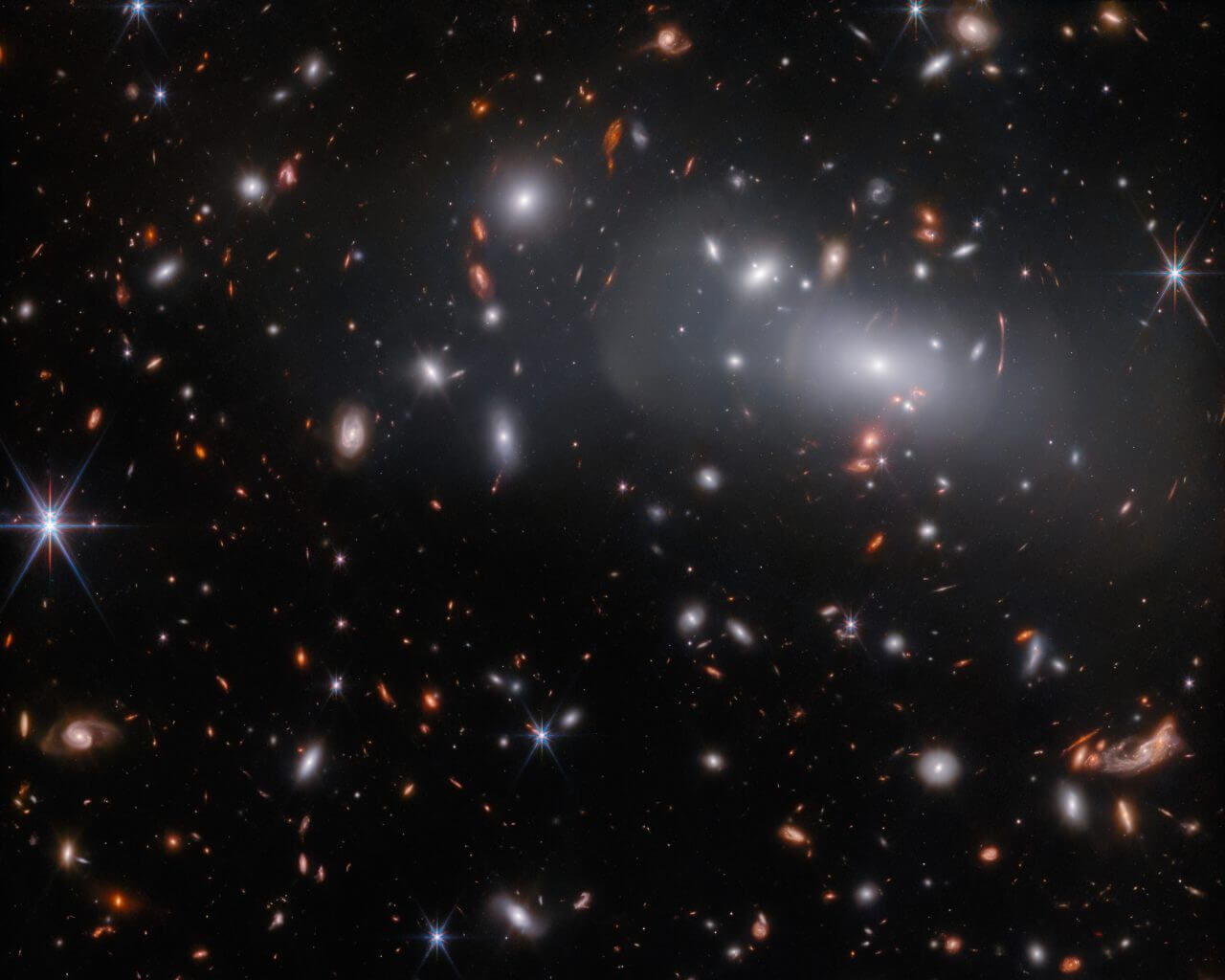[▲مجموعةمجرات”RXJ2129″تمالتقاطهابواسطةكاميراالأشعةتحتالحمراءالقريبة(NIRCam)لتلسكوبجيمسويبالفضائي(Credit:ESA/Webb،NASA&CSA،P.Kelly)]
This image captures the galaxy cluster RX J2129, about 3.2 billion light-years away in the direction of Aquarius. Seen from the center, the Brightest Cluster Galaxy: BCG is visible in the upper right. Interestingly, many arc-shaped celestial bodies are visible around the bright galaxy. These objects appear distorted due to the “gravitational lensing” effect of RX J2129.
Gravitational lensing is the distortion of space-time due to the mass of the celestial body in front (the lens of the celestial body), which changes the direction of transmission of the light emitted by the celestial body (light source) on the other side, and the image on the ground is a phenomenon in which the image of the same celestial body is enlarged and sometimes divided into multiple parts . In the case of this image, it is seen as a distorted image from Earth because the direction of the light emitted by the galaxy on the other side of the cluster changes.
According to the European Space Agency (ESA), you can also see an image of the same galaxy divided into three by gravitational lensing. In that galaxy, a supernova “AT 2022riv” was found on August 7, 2022, but strangely enough, only one of the three images in this image shows AT 2022riv, and it is said that it did not appear in the other two images.
The reason for this is that the direction of light travel has changed due to the effect of gravitational lensing, so the distance that the light travels before it reaches the ground (the time it takes for the light to reach the ground) is also different for each image. All three images are images of the same galaxy, but the image takes the longest time for light to reach Earth, while the other two images reach Earth only 320 days or 1000 days earlier. In other words, we can observe the same galaxy 320 days later and 1000 days later at the same time.
In this case, the supernova only appeared in the image that takes longer to reach light, the oldest of the three split images, but it reverses the situation after 320 days and 1000 days. Vision. It’s only a small time difference compared to billions of years, but even so, it makes me realize again that a supernova is a phenomenon that develops in a short period of time in places that can be seen or not.
![【▲ A picture of the galaxy where the supernova AT 2022riv was detected (right column) is divided into three parts, and a diagram showing the position in the first picture. The middle image shows a supernova, but the bottom image after 320 days and the top image after 1000 days are already gone. (Credit: ESA/Webb, NASA & CSA, P. Kelly)]](https://sorae.info/wp-content/uploads/2023/03/galaxy-cluster-RX-J2129-AT2022riv-ESA-Webb-potm2302b.jpg)
【▲ A picture of the galaxy where the supernova AT 2022riv was detected (right column) is divided into three parts, and a diagram showing the position in the first picture. The middle image shows a supernova, but the bottom image after 320 days and the top image after 1000 days are already gone. (Credit: ESA/Webb, NASA & CSA, P. Kelly)]
The first image was created from data acquired by the James Webb Space Telescope’s Near Infrared Camera (NIRCam), which uses six types of infrared filters.(※)by the European Space Agency as “Webb Space Telescope Image of the Month” on February 28, 2023.
* … Because the Webb Space Telescope primarily monitors infrared wavelengths that the human eye cannot see, the colors in the published images are those that are colored in according to the filters used during acquisition. In this image, 1.15 µm and 1.5 µm are colored blue, 2.0 µm and 2.77 µm are colored green, and 3.56 µm and 4.44 µm are colored red.
It is said that AT 2022riv may be a “type Ia supernova” that includes a white dwarf. Type Ia supernovae, whose true brightness is approximately constant, can be used as one of the “standard light sources” used to measure distances in space, since the distance from Earth can be calculated based on the observed apparent brightness. This is a phenomenon that has been exploited.
According to ESA, the Webb Space Telescope’s NIRCam measured the brightness of AT 2022riv, and spectroscopic observations (observations to obtain the spectrum, which is the intensity of each wavelength of electromagnetic waves) were carried out using a Near Infrared Spectrometer (NIRSpec). As a result, it became possible to compare Type Ia supernovae in the near universe with supernovae in the distant universe. This is important in determining if one of the tried and tested methods of measuring distance is working as expected.
<يتم التعبير عن المسافات في المقالة على أنها "مسافات المسار البصري" (مسافات مسار الضوء) ، والتي تشير إلى المسافة التي يقطعها الضوء المنبعث من الجسم السماوي قبل ملاحظته على الأرض.>
source
- Image credit: ESA/Webb, NASA & CSA, P. Kelly
- ESA/web Triple vision
Sentence editing section

“Travel maven. Beer expert. Subtly charming alcohol fan. Internet junkie. Avid bacon scholar.”






More Stories
It's better to call it a digital camera. The Xperia 1 VI lets you take any kind of photo | Gizmodo Japan
Google may be developing a new device called “Google TV Streamer” to replace “Chromecast”
What do you want to talk about? “Persona 3 Reload” recommendation campaign is running until July 31st! |.Persona Channel